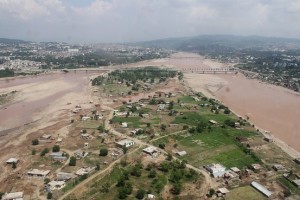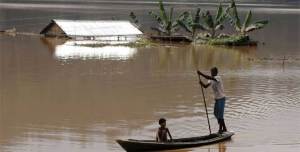Recurring Floods in the Hills: ‘Natural’ or ‘Man-made’?

Over the past few weeks, vast parts of Jammu and Kashmir, Assam and Meghalaya have been reeling under the onslaught of massive rains and floods. Thousands and thousands are still grappling with the subsequent devastation and loss of lives and livelihoods. In the mainstream discourse, floods are normally visualized as a ‘natural’ calamity, which human societies have to deal with. The fact remains that floods, earthquakes and other such ‘natural’ calamities are often triggered off or exacerbated by human activity. An entire range of research has now underlined the implications of human intervention on sensitive ecosystems, and the disastrous impacts that could follow.
Jammu and Kashmir has recently faced the one of the deadliest floods in living memory. An estimated 450 villages went under water. Given the extent of the disaster, it is indeed amazing that the government forecasts completely ignored all warning signs of the impending disaster. The Central Water Commission (CWC), which functions under the Union Ministry of Water Resources and is meant to issue flood forecasts and related advisories to various states, has no forecast for any place in Jammu and Kashmir! As the situation leading to the floods was building up, the CWC did not bother to even monitor Jammu and Kashmir. Neither does the CWC make public hydrographs for the rivers in Jammu and Kashmir. This is despite the fact that the India Meteorological Department clearly indicated heavy rainfall in the state. Last year too, the CWC completely failed to provide any flood forecast when Uttarakhand faced its worst floods.

Such shocking omissions by bodies such as the CWC, which fail to perform their responsibilities, are however just one of the ways in which human interventions play a role in ‘natural’ calamities. It is now a well-established fact that rampant and unregulated construction activity in the eco-sensitive and fragile hills, and moreover the construction of hydropower projects have had a disastrous impact on the local ecology. For instance, the fact of the matter is that the Union Ministry of Environment and Forests has been clearing hydropower projects in the Chenab basin even without proper social and environment impact assessment. As a result, the disaster potential in Chenab has only increased. In the entire north-east too, huge hydropower projects are being constructed across several rivers without any scientific assessment of the cumulative impact of such projects. Moreover, mining activity has only been increasing in the hilly Himalayan terrains as well as in the North-East. In Meghalaya for instance, there are proposals for large-scale mining of limestone.
Today, the possible impact of our ‘development’ policy – of the constant destabilization of the mountain ecosystem through massive construction of roads, highways and dams – is widely recognized.
After the horrific floods in Uttarakhand last year, the Supreme Court intervened highlighting precisely these concerns. In August last year, the Supreme Court ordered the MoEF to appoint an expert committee to ascertain whether existing and under-construction hydropower plants and projects in Uttarakhand contributed to the flood disaster that hit the state in June. At the same time the apex court had ordered a fresh scrutiny of the proposed 24 hydropower projects on Alaknanda and Bhagirathi rivers, which environmental activists and expert bodies have been opposing. The SC had also ordered MoEF and the Uttarakhand government not to give any more environment clearances for hydroelectric projects in Uttarakhand.
It is indeed unfortunate that both the UPA and the NDA, driven and dictated by corporate interests, are committed to the paradigm of unregulated tourism, of big dams and unfettered mining, of construction of roads, bridges and townships everywhere in the fragile hills. It is high time that we wake up to the need of an entirely new model of development, in the hill regions, and also the rest of the country.
Photo Courtesy: http://blogs.wsj.com/indiarealtime/2014/09/09/more-rain-on-the-way-for-flood-hit-kashmir/

Chage the System, Not the Climate’